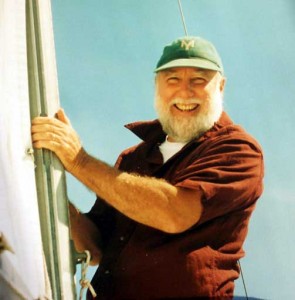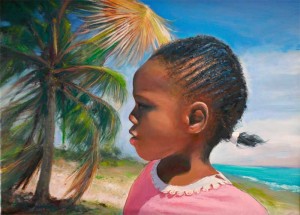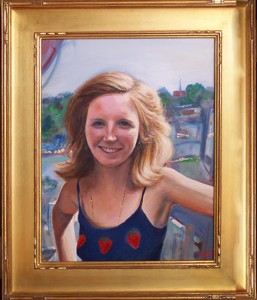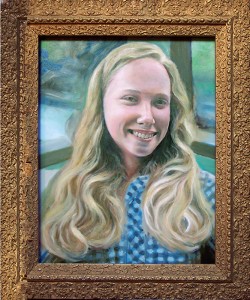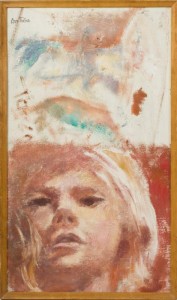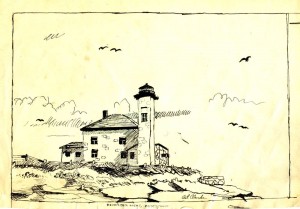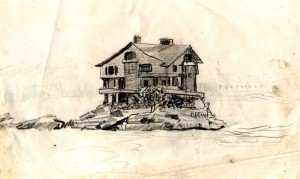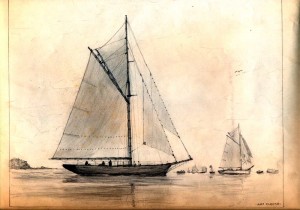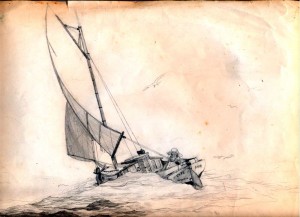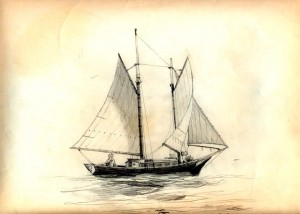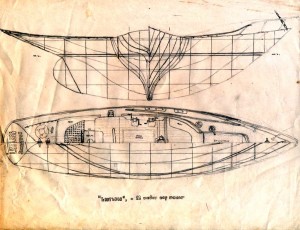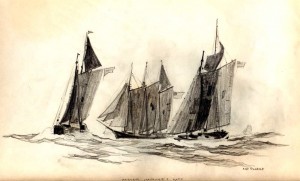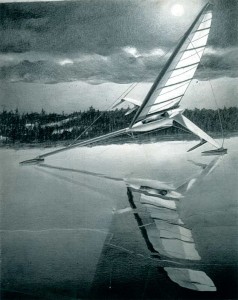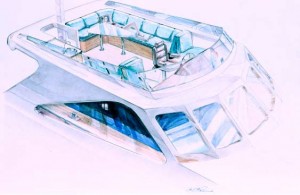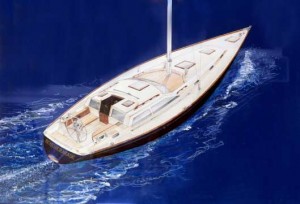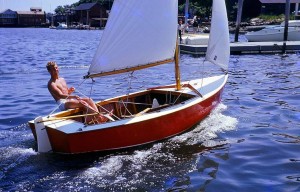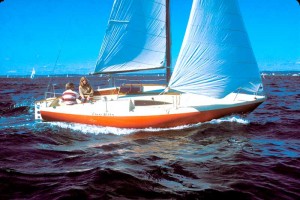What’s in a name? Although it was happenstance that his parents named him Arthur (after his maternal grandfather), who would deny that the monicker Art ended up spot-on? Art was a right-brained, fanatical artist since earliest memory. Art and his twin brother were raised on a supremely beautiful island and surrounded by the sea which manages to flow its way into so many of Art’s paintings. Nowadays the island of Jamestown, in the middle of Narragansett Bay, Rhode Island, has to be one of the loveliest and most interesting places in the world. In the 1940’s not only were there stupendous views as now, but the history, culture, and romance of the place were compelling. All around were cliffs and beaches, and Navy ships come home from the war, mansions and yachts and ferries, boatbuilding shops, malodorous farms, fields that yielded up Indian relics, windmills, lighthouses, forts and fishing camps, lurking out there and begging to be sketched and painted given the rare opportunity of a world class talent that settles, rarely, on a single man.
The people of this off-the-social-map island were equally intriguing, because this was a community that housed every stratum from town sots to the Four Hundred. Retired admirals lived on Shoreby Hill; artists like William Trost Richards and Alfred Thompson Bricher made the island posthumously famous in seascapes long before their works were recognized and bid into the stratosphere, and Art swooned over them as a child. The twins were often placed in the care of their proud grandfather, a tall, charismatic jack-of-all-trades who imparted the lore of idyllic times and the ethics of the Greatest Generation. 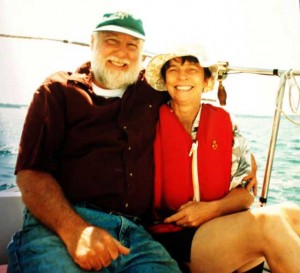 The island population was a feast for portraiture. Between the two-room school and the strict dictates of Church to the hunters and fishermen in Art’s grandfather’s world, an island kid stood in awe of all manner of perfidious characters from the close to sacred to the truly profane. Lots of time was spent with old folk, being driven in decrepit Ford pickups and passing along tales of legendary pirates, storms much magnified by the passage of time, fortunes gained and lost, and odd sorts who were remembered standing on windy headlands and applying pigmented goo to stretched canvas without the slightest inkling that their efforts would yield millions of dollars with the passage of time. Every object in the child artist’s world was imbued with adventure, character, mystery and color. Art claims that he was able to transport into whatever place he could imagine, from the gun tubs of a battleship to the steering cabin atop a ferryboat to the lair of a Barbary Pirate—all he had to do to in order to go there…was to sprawl on the creaky bare floor of a rude island shack,…..and draw!
The island population was a feast for portraiture. Between the two-room school and the strict dictates of Church to the hunters and fishermen in Art’s grandfather’s world, an island kid stood in awe of all manner of perfidious characters from the close to sacred to the truly profane. Lots of time was spent with old folk, being driven in decrepit Ford pickups and passing along tales of legendary pirates, storms much magnified by the passage of time, fortunes gained and lost, and odd sorts who were remembered standing on windy headlands and applying pigmented goo to stretched canvas without the slightest inkling that their efforts would yield millions of dollars with the passage of time. Every object in the child artist’s world was imbued with adventure, character, mystery and color. Art claims that he was able to transport into whatever place he could imagine, from the gun tubs of a battleship to the steering cabin atop a ferryboat to the lair of a Barbary Pirate—all he had to do to in order to go there…was to sprawl on the creaky bare floor of a rude island shack,…..and draw!
Art Paine may be legitimately compared to Michaelangelo, in that he’s been attracted to mechanics and inventions as well as pictorial art. He is intrigued with most anything that moves—through the air, on water (liquid or solid—as ice) as well as in the automotive realm. He spent many years working as a yacht captain and sea rover for pay, and surely all these things combine to give his artworks a look of accuracy and function—when that is his goal.
Art has designed (perhaps invented is a better word) several benchmark boats that, being years ahead of their time, missed a market that only evolved decades after their conception. He experimented with one-piece, stressed-skin construction with his “Two Bits”, a small fiberglass racing yacht. His highly experimental “Paine Monomaran” was a proposed Olympic racer, contrived to be built over an aluminum and wire truss framework. A mere 300 pounds of hull was stabilized by 1400 pounds of torpedo-like ballast keel! The design, intended to achieve high speed through slenderness, like a catamaran, was as you might say, too clever by half! Exactly half. It sailed great, but sunk unpredictably on its mooring in a storm as waves just a fraction taller than its freeboard swept down its considerable length. Who woulda’ thought? His biggest yacht design was the exquisitely beautiful AIRFORCE, a 46 foot varnished mahogany sloop that raced in the 1995 B.O.C. Challenge singlehanded around the world race. Art continues to work as a consultant to people who are having a boat built and outfitted. Those who inspire to think a paradigm ahead of the norm would do well to have a word with him.
Art is best known for his marine works, and rightly so, but he is also accomplished at landscape and portraiture. His viewpoint on portraits is very similar to that regarding boats. Although he always tries to use playful brushwork respectful to that of his idols, the Impressionists, he takes great pains to insure an accurate likeness. No matter how dashed-off or distant it might appear, a boat in a painting has to read not only as properly proportioned and in perfect perspective, but it must be instantly recognized as the particular boat intended. The same is true with faces.
Like all truly great artists, his talent in paint and pencil cannot be attributed to any formal training, and those around him contend that he was born with a pencil in his hand. Born in 1944, Art cannot recall when he began drawing, but it was certainly during his early childhood when he lived on Jamestown. Perhaps the smoke and steam that wafted from the steam powered ferry that connected his boyhood home with glitzy Newport mixed with primordial seawater in his coalescing brain to ingrain the fluid, nautical way his hand guides a pen or brush?
Art’s work is truly original and easily distinguishable from that of any other artist. Amazingly, there are elements of his style that can be traced back to his earliest childhood efforts, examples of which are depicted below.

The earliest known work by Art Paine. It depicts the steam-powered ferry that connected his boyhood island, Jamestown, Rhode Island, with nearby Newport. There’s a playful quality to the pen-strokes that remains in Art’s work sixty years later.
Surrounded by works of the original Artist, he developed a love of nature and of sea and sky that translated into a life crafting boats, drawing boats, painting the sea, and writing in his easily recognizable and irreverent style. His degree in fine art from University of Rhode Island merely put sheepskin to a talent that was fully developed in his teens and can probably not be taught. How do you teach a hand to move in such a delightful way?
Like many fine artists before him including Winslow Homer, whom his paintings most closely resemble, Art has kept the wolf from the door much of his life working as a commercial illustrator. A true Renaissance man, he’s tried his hand at many crafts, as long as they could be considered an act of creation and involved wielding a tool in his hand. Art has always loved “building things”, which involved drawings to get it designed and illustrations to get it sold- from iceboats to automobiles to yachts.
For many years he was the primary illustrator at his brother Chuck’s yacht design studio. Art was the one whom his twin would call upon whenever color perspectives were required. From the very beginning of each project, the clients were presented with preliminary renderings of their dream yachts in perspective view, planing along on sunlit days in full color, usually with a buxom nude at the helm, her flaxen hair streaming.
Not content to restrict his creativity to two dimensions, and a hopeless boat lover, Art has designed and built boats beginning from his early teens. Some examples of his nautical artistry with wood and metal are illustrated below.
While Art has occasional showings of his most recent works, your best bet is to try to find him in his studio, a turret overshadowing his home in Bernard, Maine. Phone ahead, of course, (207) 244-5845.
